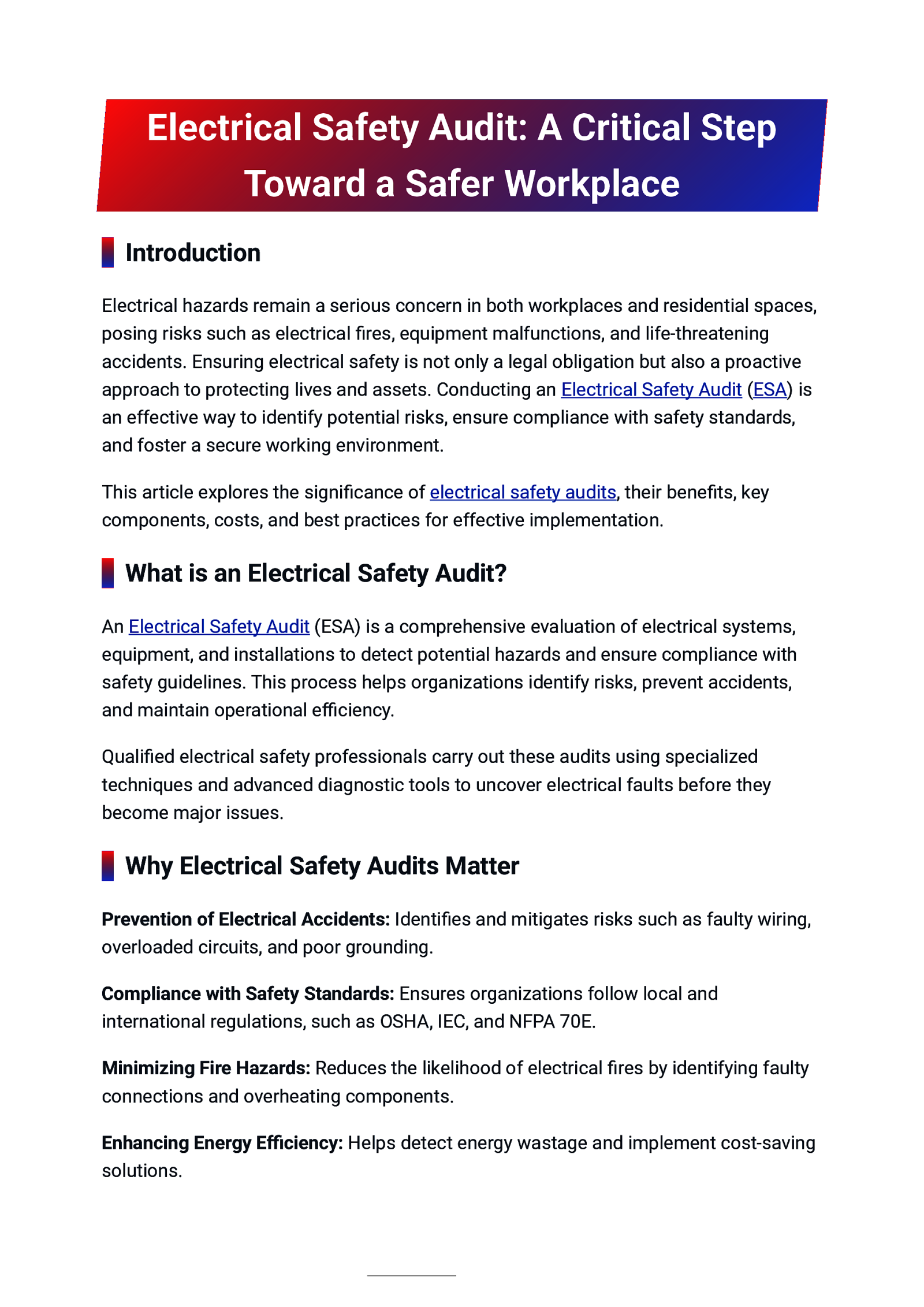A presentation at electrical safety audit in in India by Nitin Elion

Electrical Safety Audit: A Critical Step Toward a Safer Workplace Introduction Electrical hazards remain a serious concern in both workplaces and residential spaces, posing risks such as electrical fires, equipment malfunctions, and life-threatening accidents. Ensuring electrical safety is not only a legal obligation but also a proactive approach to protecting lives and assets. Conducting an Electrical Safety Audit (ESA) is an effective way to identify potential risks, ensure compliance with safety standards, and foster a secure working environment. This article explores the significance of electrical safety audits, their benefits, key components, costs, and best practices for effective implementation. What is an Electrical Safety Audit? An Electrical Safety Audit (ESA) is a comprehensive evaluation of electrical systems, equipment, and installations to detect potential hazards and ensure compliance with safety guidelines. This process helps organizations identify risks, prevent accidents, and maintain operational efficiency. Qualified electrical safety professionals carry out these audits using specialized techniques and advanced diagnostic tools to uncover electrical faults before they become major issues. Why Electrical Safety Audits Matter Prevention of Electrical Accidents: Identifies and mitigates risks such as faulty wiring, overloaded circuits, and poor grounding. Compliance with Safety Standards: Ensures organizations follow local and international regulations, such as OSHA, IEC, and NFPA 70E. Minimizing Fire Hazards: Reduces the likelihood of electrical fires by identifying faulty connections and overheating components. Enhancing Energy Efficiency: Helps detect energy wastage and implement cost-saving solutions.
Protecting Lives and Property: Creates a safer workplace by minimizing electrical risks and ensuring the reliability of systems. Essential Aspects of an Electrical Safety Audit 1. Inspection of Electrical Systems Examining electrical panels, wiring, and switchboards Checking for loose connections, overheating, and damaged insulation Evaluating the performance of circuit breakers and protective devices 2. Assessment of Wiring and Earthing Systems Identifying outdated or damaged wiring that could pose safety risks Ensuring proper grounding to prevent electric shocks Measuring earthing resistance to confirm effective fault current dissipation 3. Load Distribution and Energy Optimization Detecting circuits operating beyond their capacity Reviewing energy consumption patterns to identify inefficiencies Recommending measures such as LED lighting and energy-efficient devices 4. Testing of Electrical Safety Devices Checking the functionality of surge protectors, relays, and circuit breakers Verifying the effectiveness of backup power systems (UPS, generators, etc.) Inspecting lightning protection systems to prevent voltage surges 5. Ensuring Regulatory Compliance Confirming that electrical installations meet local and global safety standards Aligning electrical systems with NEC, ISO, and OSHA guidelines Documenting risk mitigation strategies and compliance reports 6. Fire Risk Evaluation Identifying components that could overheat and cause fires
Ensuring fire-resistant insulation materials are used Checking emergency response measures, including fire extinguishers and alarms Electrical Safety Audit Standards in India India has established specific safety standards to regulate electrical audits. These include: IS 732: Guidelines for safe electrical wiring installations IS 3043: Earthing system safety standards Electricity Act, 2003: Governing framework for electrical safety and operations National Building Code (NBC), 2016: Best practices for safe electrical installations Central Electricity Authority (CEA) Regulations: Rules for electrical system maintenance and inspections Cost and Fees for Electrical Safety Audits The cost of an electrical safety audit varies depending on several factors, such as: The size and complexity of the facility Industry type (industrial, commercial, or residential) The extent of testing required The credentials and experience of the auditor In India, the cost of an electrical safety audit typically ranges from ₹15,000 to ₹1,00,000, with large industrial complexes requiring more extensive audits, which increase the fees. Best Practices for Conducting an Electrical Safety Audit Engage Certified Electrical Safety Auditors: Ensure that qualified professionals with relevant expertise perform the audit. Utilize Advanced Diagnostic Tools: Use infrared thermography, insulation resistance testers, and energy analyzers for precise assessments. Schedule Regular Audits: Conducting periodic audits (at least once a year) helps maintain high safety standards.
Train Employees on Electrical Safety: Educate workers about safe electrical practices and emergency procedures. Address Safety Issues Promptly: Implement corrective measures as soon as risks are identified. Maintain Comprehensive Documentation: Keep detailed audit reports, compliance records, and risk assessments for future reference. Conclusion Conducting an electrical safety audit is a proactive step in ensuring a secure workplace, preventing electrical hazards, and complying with safety standards. Regular audits help businesses minimize risks, improve energy efficiency, and protect employees and assets. If you’re looking to enhance the electrical safety of your facility, consulting a certified electrical safety auditor is the best way to ensure compliance and safety.
Elion Technologies provides fire audits, risk assessments, compliance checks, and training to ensure safety and compliance. Contact us today to protect your business!
To Known More About - Elion Technologies
Thermal Audit Services, Energy Audit Report, Energy Audit, energy audit, thermal audit, Thermal Energy Audit, Energy Efficiency Audit, Building Thermal Audit, electrical audit, Electric Audit, thermography audit, Electric Thermography Audit, Thermal Inspection, Fire Safety Audit, fire audit, Safety Audit, audit,